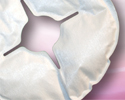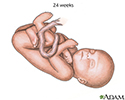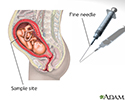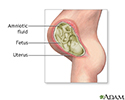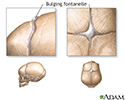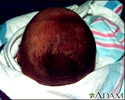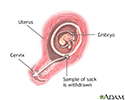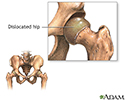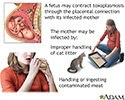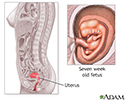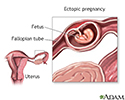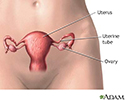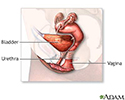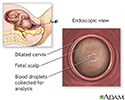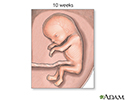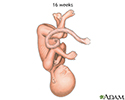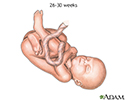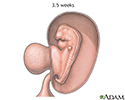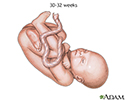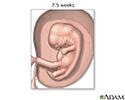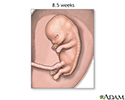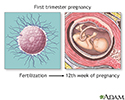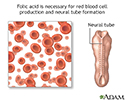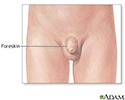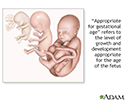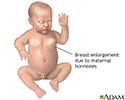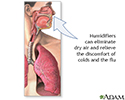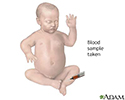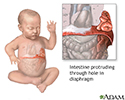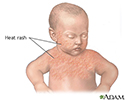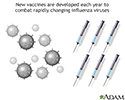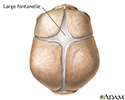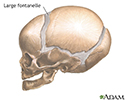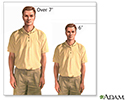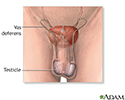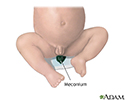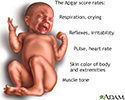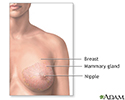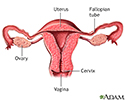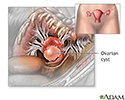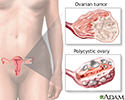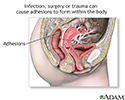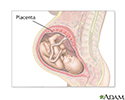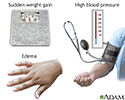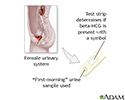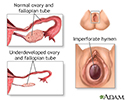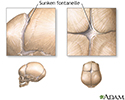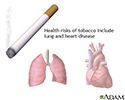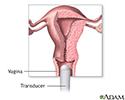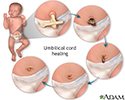Multimedia Gallery
Conception - pregnancy
In this cut -away view you can see both the woman’s and the man’s reproductive organs during intercourse. Here are the penis, vagina, uterus, testicle and prostate gland.
During sexual intercourse, the sperm are released into the vagina near the cervix, which is the entrance to the uterus. Here you can see the sperm swimming through the uterus and up the fallopian tubes. From their profiles, you can see the sperm actually have 3 parts: a head, a middle section, and a tail, which propels them through the uterus.
If you take a closer look at the sperm's head, you’ll see that its covered with an enzyme "cap" that will help it break through the outer wall of the egg cell.
Also within the head are clumps of chromosomes. Chromosomes contain the genetic material, or genes, that are the hereditary blueprints that get passed on to the baby. If a sperm containing a Y chromosome fertilizes the egg, the baby will be a boy. If the lucky sperm contains an X Chromosome, then the baby will be a girl. In addition to a baby’s sex, the genes on the chromosomes determine thousands of other characteristics, including height, body shape, facial features and eye color, and may even influence characteristics like talent and aptitude.
Now let's see what's going on with the egg cell.
Here's the egg cell, moving through the fallopian tube. It can't swim by itself, so it gets moved along by the beating motion of tiny cilia that line the walls of the tube. Unless it gets fertilized, an egg can only survive for 12-24 hours after ovulation. Here you see the egg being met by the sperm. All of the sperm are trying to penetrate the egg.
Actually those sperm are the only remaining survivors of the millions of sperm that were released into the woman’s reproductive tract. The woman’s reproductive tract has an acidic lining and a host of cellular defense mechanisms, making it a hostile environment, and few sperm are strong enough to make it to the egg.
If you watch now you can see the process of fertilization beginning. When one of the sperm cells finally succeeds in breaking through the egg cell's outer membrane, you’ll see something remarkable happen. There it is! The egg cell is locking out other sperm cells from entering. This ensures that only one sperm cell fertilizes the egg cell. If more than one sperm cell was involved, the egg cell might not survive because it would have the wrong amount of genetic material.
Now, here's the final part of fertilization: the sperm cell releases its nucleus containing the father’s chromosomes and then after several hours it unites with the nucleus of the egg cell, which contains the mother’s chromosomes. And when the two nuclei fuse, their genetic material combines together to create a zygote, which is what a fertilized egg cell is called.
Conception - pregnancy
Review Date: 5/14/2024
Reviewed By: John D. Jacobson, MD, Professor Emeritus, Department of Obstetrics and Gynecology, Loma Linda University School of Medicine, Loma Linda, CA. Also reviewed by David C. Dugdale, MD, Medical Director, Brenda Conaway, Editorial Director, and the A.D.A.M. Editorial team.
Animations
- Breast engorgement
- Cell division
- Cesarean section
- Conception - general
- Conception - pregnancy
- Conception of identical twins
- C-section
- Early labor
- Egg cell production
- Egg production
- Endometriosis
- Fetal ear development
- Formation of twins
- Human face formation
- Infant formulas
- Kids - How big is the baby?
- Kids - How does the baby co...
- Kids - Is it a girl or boy?
- Kids - Umbilical cord
- Kids - Where do babies come...
- Newborn jaundice
- NICU consultants and suppor...
- Ovulation
- Placenta delivery
- Placenta formation
- Preeclampsia
- Pregnancy
- Pregnancy care
- Sperm production
- Sperm release pathway
- Storing breast milk
- The role of amniotic fluid
- Twin-to-twin transfusion sy...
- Ultrasound
- Vaginal delivery
Illustrations
- 24-week fetus
- Abnormal discharge from the...
- Abnormal menstrual periods
- Absence of menstruation (am...
- Amniocentesis
- Amniocentesis
- Amniotic fluid
- Amniotic fluid
- Anatomy of a normal placenta
- Antibodies
- Baby burping position
- Bananas and nausea
- Blood cells
- Blood test
- Breast infection
- Breastfeeding
- Bulging fontanelles
- Candida - fluorescent stain
- Caput succedaneum
- Cesarean section
- Cesarean section
- Cesarean section
- Childbirth
- Chorionic villus sampling
- Congenital hip dislocation
- Congenital toxoplasmosis
- Crying - excessive (0 to 6 ...
- Delivery presentations
- Developmental milestones
- Early weeks of pregnancy
- Ectopic pregnancy
- Emergency Childbirth
- Emergency Childbirth
- Endocrine glands
- Endometriosis
- Endometritis
- Erythroblastosis fetalis - ...
- Female breast
- Female reproductive anatomy
- Female reproductive anatomy
- Female reproductive anatomy...
- Female urinary tract
- Fetal blood testing
- Fetal head molding
- Fetus at 10 weeks
- Fetus at 12 weeks
- Fetus at 16 weeks
- Fetus at 26 to 30 weeks
- Fetus at 3.5 weeks
- Fetus at 30 to 32 weeks
- Fetus at 7.5 weeks
- Fetus at 8.5 weeks
- First trimester of pregnancy
- Folic acid
- Folic acid benefits
- Folic acid source
- Follicle development
- Fontanelles
- Foreskin
- Gestational ages
- Gestational diabetes
- Gonadotropins
- Head circumference
- Heat rash
- Height/weight chart
- Hormonal effects in newborns
- Humidifiers and health
- Hysterectomy
- Infant blood sample
- Infant care following delivery
- Infant diaphragmatic hernia
- Infant heat rash
- Infant intestines
- Infant jaundice
- Infantile reflexes
- Influenza vaccines
- Intraductal papilloma
- Intrauterine transfusion
- Jaundiced infant
- Large fontanelles
- Large fontanelles (lateral view)
- Macrosomia
- Male reproductive anatomy
- Male reproductive anatomy
- Male urinary tract
- Mammary gland
- Meconium
- Morning sickness
- Moro reflex
- Newborn head molding
- Newborn test
- Normal female breast anatomy
- Normal uterine anatomy (cut...
- Ovarian cyst
- Ovarian hypofunction
- Overproductive ovaries
- Pelvic adhesions
- Pelvic laparoscopy
- Placenta
- Placenta
- Placenta
- Placenta previa
- Polyhydramnios
- Preeclampsia
- Pregnancy test
- Primary amenorrhea
- Primary infertility
- Secondary amenorrhea
- Secondary infection
- Side sectional view of fema...
- Single palmar crease
- Skull of a newborn
- Slit-lamp exam
- Sperm
- Stein-Leventhal syndrome
- Sunken fontanelles (superio...
- Tobacco health risks
- Transvaginal ultrasound
- Ultrasound in pregnancy
- Ultrasound, color - normal ...
- Ultrasound, normal fetus - ...
- Ultrasound, normal fetus - ...
- Ultrasound, normal fetus - ...
- Ultrasound, normal fetus - face
- Ultrasound, normal fetus - ...
- Ultrasound, normal fetus - foot
- Ultrasound, normal fetus - ...
- Ultrasound, normal fetus - ...
- Ultrasound, normal fetus - ...
- Ultrasound, normal fetus - ...
- Ultrasound, normal placenta...
- Ultrasound, normal relaxed ...
- Umbilical cord healing
- Uterus
- Vaginal bleeding during pre...
- Well baby visits
- Yeast infections

 Bookmark
Bookmark



























